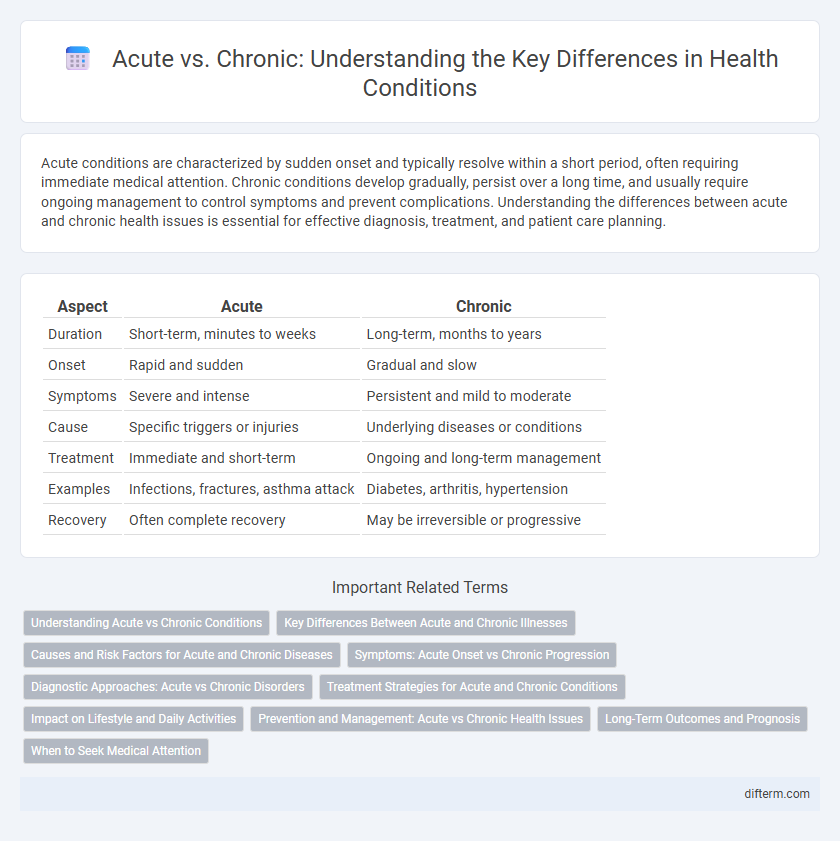Acute conditions are characterized by sudden onset and typically resolve within a short period, often requiring immediate medical attention. Chronic conditions develop gradually, persist over a long time, and usually require ongoing management to control symptoms and prevent complications. Understanding the differences between acute and chronic health issues is essential for effective diagnosis, treatment, and patient care planning.
Table of Comparison
| Aspect | Acute | Chronic |
|---|---|---|
| Duration | Short-term, minutes to weeks | Long-term, months to years |
| Onset | Rapid and sudden | Gradual and slow |
| Symptoms | Severe and intense | Persistent and mild to moderate |
| Cause | Specific triggers or injuries | Underlying diseases or conditions |
| Treatment | Immediate and short-term | Ongoing and long-term management |
| Examples | Infections, fractures, asthma attack | Diabetes, arthritis, hypertension |
| Recovery | Often complete recovery | May be irreversible or progressive |
Understanding Acute vs Chronic Conditions
Acute conditions are characterized by sudden onset and short duration, often requiring immediate medical attention, such as infections or injuries. Chronic conditions develop gradually and persist for extended periods, frequently involving long-term management, examples include diabetes and hypertension. Understanding the differences helps optimize treatment strategies and improve patient outcomes through timely intervention and continuous care.
Key Differences Between Acute and Chronic Illnesses
Acute illnesses are characterized by sudden onset and typically short duration, often resolving with appropriate treatment, while chronic illnesses develop gradually and persist over a long period, frequently requiring ongoing management. Acute conditions such as influenza or appendicitis usually involve intense symptoms that subside, whereas chronic diseases like diabetes, arthritis, or heart disease result in prolonged health complications and progressive tissue damage. Understanding these distinctions is crucial for tailoring patient care strategies, managing symptoms effectively, and improving overall health outcomes.
Causes and Risk Factors for Acute and Chronic Diseases
Acute diseases typically arise from sudden infections, injuries, or environmental exposures, with risk factors including weakened immunity and high pathogen exposure. Chronic diseases develop from prolonged lifestyle factors such as poor diet, sedentary behavior, and genetic predisposition, leading to conditions like diabetes, heart disease, and cancer. Environmental pollutants, stress, and unmanaged acute conditions can also contribute to the transition from acute to chronic illnesses.
Symptoms: Acute Onset vs Chronic Progression
Acute symptoms typically present suddenly and with high intensity, often indicating immediate or severe health issues requiring prompt medical intervention. Chronic symptoms develop gradually over time, showing persistent or recurring patterns that may signal long-term conditions impacting daily functioning. Recognizing the difference between acute onset and chronic progression is essential for accurate diagnosis and effective treatment planning.
Diagnostic Approaches: Acute vs Chronic Disorders
Diagnostic approaches for acute disorders prioritize rapid identification through clinical evaluation, laboratory tests, and imaging to address immediate symptoms, often within hours or days. Chronic disorders require comprehensive diagnostic strategies, including long-term monitoring, specialized imaging, and biomarker analysis to assess disease progression and manage ongoing symptoms. Differentiating between acute and chronic conditions hinges on symptom duration, diagnostic timelines, and the use of targeted tests such as blood panels for inflammatory markers or advanced imaging techniques like MRI.
Treatment Strategies for Acute and Chronic Conditions
Treatment strategies for acute conditions prioritize rapid intervention to alleviate symptoms and prevent complications, often involving short-term medications, surgery, or hospitalization. Chronic conditions require long-term management through lifestyle modifications, continuous medication, regular monitoring, and multidisciplinary care to control symptoms and prevent disease progression. Personalized treatment plans based on patient history and comorbidities enhance efficacy in managing both acute and chronic health issues.
Impact on Lifestyle and Daily Activities
Acute health conditions typically require short-term intense treatment, often causing temporary disruptions in daily activities and lifestyle. Chronic illnesses demand ongoing management, leading to long-term lifestyle adjustments such as dietary changes, medication adherence, and activity limitations. The persistent nature of chronic diseases significantly impacts physical, emotional, and social aspects of daily life compared to the transient effects of acute conditions.
Prevention and Management: Acute vs Chronic Health Issues
Prevention of acute health issues often involves immediate interventions such as vaccinations, hygiene practices, and prompt medical treatment to avoid complications. Chronic health conditions require ongoing management through lifestyle modifications, regular monitoring, medication adherence, and routine healthcare visits to prevent exacerbations. Effective strategies for both acute and chronic issues emphasize early detection and patient education to optimize health outcomes.
Long-Term Outcomes and Prognosis
Acute health conditions typically present rapid onset and are often resolved with short-term treatment, resulting in generally favorable long-term outcomes and prognosis. Chronic diseases, characterized by persistent and progressive symptoms, frequently require continuous management and are associated with variable long-term prognoses, including potential complications and diminished quality of life. Effective management strategies for chronic conditions significantly influence prognosis by slowing disease progression and improving long-term outcomes.
When to Seek Medical Attention
Seek immediate medical attention if acute symptoms such as severe chest pain, sudden shortness of breath, or intense abdominal pain occur, as these may indicate life-threatening conditions. For chronic symptoms like persistent fatigue, ongoing pain, or unexplained weight loss lasting weeks or months, consult a healthcare provider for proper diagnosis and management. Early intervention in both acute and chronic cases improves health outcomes and prevents complications.
Acute vs Chronic Infographic

 difterm.com
difterm.com